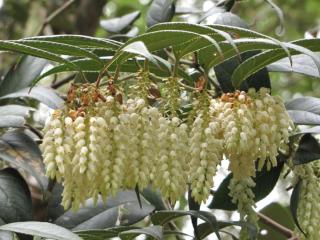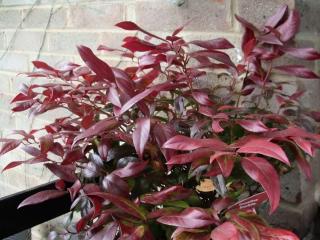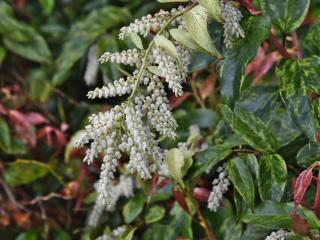

Leucothoe is a charming little shrub both for its flowers and leaves.
Leucothoe key facts:
Latin Name: Leucothoe spp.
Common Name: Leucothoe
Family: Ericaceae
Type: shrub
Shape: rounded
Width, Height: 2½ to 3 ft depending on species (0,80 to 1 m)
Exposure: part to full shade
Soil: acidic, humus-rich, moist
Hardiness: hardy down to 5°F (-15°C)
Growth: slow – Foliage: evergreen – Blooming: spring
The Leucothoe genus has got shrubs mostly known for their evergreen leaves. Yet, some species might surprise you with semi-evergreen or even deciduous habits.
Whether you consider its foliage or its flowers, leucothoe offers a dual decorative appeal. Two of the more appreciated species are L. fontanesiana and L. Scarletta ‘Zeblid’.
Spotlight on this variety: evergreen leaves on arching branches. Think green, glossy, lance-shaped leaves. During the springtime, it flaunts short, drooping clusters. It is similar in a way to heather, which, no surprise, are part of the same family.
This leucothoe has a more compact stature than its ‘Rainbow’ cousin. What sets it apart is its changing foliage.
Leaves indeed start off with a purple-red hue, then mature to dark green, and finally, come autumn, take on a stunning bronze highlight. This beauty shines brightest in winter when garden colors are on vacation.
To thrive, a Leucothoe needs a spot in partial to full shade. For soil, choose one with acidic pH, rich in organic matter and moist to wet.
The best time to plant is early fall, when moisture returns yet temperatures stay above freezing.
Thanks to its compact size, you can plant leucothoe either in-ground or in pots. Here’s how:
 Dig a good-sized, deep planting hole.
Dig a good-sized, deep planting hole.Potted planting might just be the simplest way to go. Pick the perfect spot and, using heath soil, ensure optimal substrate for your shrub.

Smart tip? Since Leucothoe loves cool roots, cover with a thick layer of pine bark after planting. This natural mulch not only slows water evaporation and weed growth but, as it breaks down, it improves soil pH and humus content.

When grown in pots, plan on repotting every 4 to 5 years. In between, top up with heath soil.
If you’ve added mulch to protect soil, remember to replenish as it decomposes.
Want new Leucothoe plants fast? Try cuttings in late summer.
Leucothoe proves robust. It’s not only hardy but also resilient. It rarely succumbs to diseases or pests.
The Leucothoe is a truly versatile shrub. Perfect for sprucing up a deck or balcony in containers, it also thrives when planted in the ground, creating a bushy display in your yard or adding volume to rock gardens.
Given its growing conditions, it pairs wonderfully with heathland plants like Japanese andromeda, Skimmia, azalea, rhododendron, Japanese maple, and camellia.